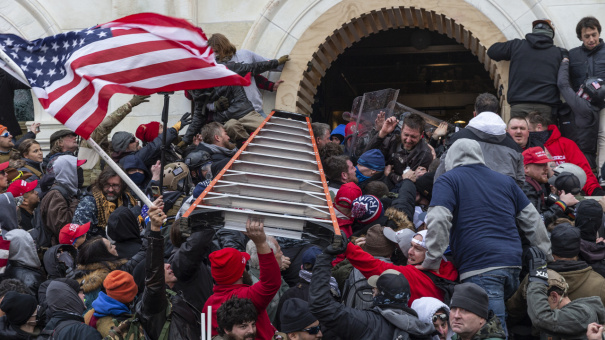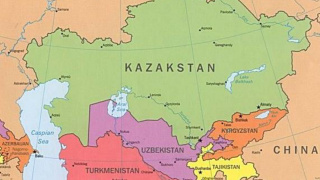The Five Crises of the American Regime
In the past eight months, two Capitol Hills have fallen. Two shocking events symbolize the abdication of authority by America’s ruling class, an abdication that has led to what can be described, not without exaggeration, as the slow-motion disintegration of the United States of America in its present form.
The first occurred on June 8, 2020, when the Seattle police evacuated their East Precinct building in the city's Capitol Hill neighborhood. Left-wing rioters stormed the police headquarters and looted it. For 24 days, Seattle’s government allowed would-be revolutionaries to create an anarchist commune, acting out the fantasy of “abolishing the police” embraced by much of the American left as well as liberals who should have known better. This anarchist commune, created in the midst of nationwide protests against the death on May 25 of a Black Minnesotan, George Floyd, in police custody, was the scene of the fatal shootings of two Black men before the police finally shut it down on July 1.
On Jan. 6, 2021, America’s elite abandoned another Capitol Hill to rioters. After President Donald Trump stirred them up in an incendiary address in which he claimed that Joe Biden had stolen the presidency from him, a mob of right-wing radicals broke into the United States Capitol, where the certification of the results of last November’s election results was taking place. Like the leaders of Seattle in June, America’s congressional leaders abandoned their posts and fled. In the ensuing chaos, the Trumpist rioters, mostly men wearing MAGA hats or more exotic outfits, posed for selfies in the well of the House chamber or in the legislative offices they broke into. A police officer killed a female rioter. Three others died as a result of “medical emergencies.” As in Seattle’s Capitol Hill, so in America’s: The forces of legitimate authority and coercive order for a period were nowhere to be seen.
What is the meaning of these dystopian scenes? Many Democrats claim that Republicans are destroying the republic. Many Republicans claim the reverse. They are both correct.
The leaders of both parties have weaponized anarchic mobs against their rivals—the Democrats, by tacitly encouraging and bailing out foundation-funded NGO staffers with secret identities and superhero-style antifa outfits during the tolerated riots of summer 2020, and now the squalid, defeated demagogue Donald Trump, unleashing his own costumed followers on the U.S. Capitol itself. As a rule, comparisons between the United States and Weimar Germany or late republican Rome are misleading, but when rival elite political factions tolerate or encourage mob violence in the streets, the comparisons might be forgiven.
A building can rot from within for a long time, before an earthquake or a fire reveals the depth of its structural decay. The COVID-19 pandemic, and the economic disaster that the subsequent lockdowns have produced, no doubt have influenced the timing of the present crisis of the American regime. But the real cause of the crisis itself, I would argue, is the confluence of five crises: A political crisis, an identity crisis, a social crisis, a demographic crisis, and an economic crisis.
The political crisis. The political crisis is the centralization of power in a small number of ambitious elite factions and coteries. Between the 1830s and the 1970s, the two major parties were coalitions of smaller, de facto parties, each of which, in turn, was a federation of state and local party organizations. The nature of the parties as pluralistic grassroots federations limited the autonomy of national politicians. It also limited the power of presidents and congressional leaders, who were picked by party bosses and had to govern by consensus.
Thanks to the misguided adoption of party primaries in the 1970s, a democratizing reform that backfired, American politicians today tend to be picked by the small number of zealots of various kinds who show up to vote in party primaries. The national parties themselves are no longer functioning organizations, but mere brands, which Donald Trump successfully seized and which Bernie Sanders, another outsider, came close to grabbing. The organizations that count are shifting, kaleidoscopic alliances of donors, politicians, consultants, media operatives and ideologues.
At the same time that the parties have crumbled as grassroots federations, politics in the United States has been nationalized. There are no longer any conservative Alabama Democrats or liberal Connecticut Republicans. The party line in each party is set by national leaders and their donors, spin doctors and pet journalists. The collapse of local journalism means that most Americans no longer get news about city and state governments. Increasingly they choose sides in city council races or state legislative races on the basis of national partisan identities.
This liberates national political leaders—Nancy Pelosi and Chuck Schumer and Mitch McConnell, no less than Barack Obama and Donald Trump—from the constraints that previous holders of the same national offices held. And the elderly boomer politicians of our time in both parties have chosen to wield their enhanced power to delegitimize the mere existence of the other party as a threat to the nation that must be humiliated if not annihilated.
The Republicans started the cycle of escalation in the 1990s. Rejecting the very idea of a bipartisan consensus, Newt Gingrich disseminated a partisan vocabulary to make it appear that Republicans favored the opposite of everything Democrats favored. Gingrich told Republicans to contrast the “conservative opportunity society” with “the liberal welfare state.” Semantic warfare was combined with quasi-military organization, as Gingrich and his Republican successors imposed a degree of discipline on the Republican Party in Congress that was alien to American traditions. The 1990s Republicans weaponized impeachment against Bill Clinton during the Monica Lewinsky scandal. As Senate majority leader, Mitch McConnell, occupying the same office as the great conciliator Lyndon Johnson, continued Newt Gingrich’s tactics of treating the Democrats as enemies to be completely thwarted, not as partners in government.
Pelosi and Schumer have been as destructive to republican norms of civility as Gingrich and McConnell. For most of Trump’s single term, they encouraged Democrats to believe the conspiracy theory that Trump had been installed in the White House by Russian President Vladimir Putin’s interference in the 2016 election. To her lasting disgrace, Pelosi extended the neo-McCarthyite rhetoric of the Russia-baiting Democrats beyond Trump, calling Senate Majority Leader McConnell “Moscow Mitch” in an attempt to paint him as an agent of a hostile foreign government.
When the Mueller report failed to prove that Trump was a Russian agent of influence, Pelosi led the House to impeach him, for trying unsuccessfully to pressure the Ukrainian government to provide dirt on Joe Biden’s son Hunter. Like Clinton’s affair with a White House intern, this was worthy of censure at most. As if any proof were needed that the United States is now a banana republic, only three presidents in American history have been impeached and two of the last four presidents have been impeached by the opposition party in Congress.
Trump’s lies about massive electoral fraud, and his implicit encouragement of mob action, has pioneered a new weapon which Democrats may yet use against Republicans, as the cycle of no-holds-barred, intra-elite feuding escalates at the top of American society.
The identity crisis. Neither America’s partisan leaders nor their militant followers are any longer restrained by a common sense of cross-party solidarity and shared American patriotism. For decades, Republican demagogues like Rush Limbaugh and Pat Buchanan and operatives like Karl Rove have told Republican voters that Democrats are “socialists” and “feminazis” who want to destroy America. For their part, many Democrats—including the almost exclusively Democratic journalists of the corporate media and the practically all-Democratic professoriate—routinely describe the half of the electorate that votes Republican as white nationalists intent on creating a dictatorship and resegregating people of color.
The propaganda of both elites finds audiences in the population, in the absence of a common American narrative. With the Civil Rights revolution, the older consensus narrative of American history from which Black Americans, Hispanics, Native Americans and Asian Americans had been airbrushed out could no longer serve as the national story of a post-apartheid society. Unfortunately, no national story that both parties could share has replaced it.
For a generation, the mainstream right, in alliance with the Rev. Pat Robertson and the Rev. Jerry Falwell, tried to replace old-fashioned Anglo-American or white nationalism with pan-Christian or panmonotheist religious nationalism. Real Americans were “people of faith.” But this was obviously just Southern white Protestant evangelical identitarianism in disguise, and failed to appeal to Catholics and Jews and other religious groups or nonwhite Americans.
For its part, the liberal left in the 1970s abandoned the idea of a common national identity in favor of hard-edged racial multiculturalism, the idea that the United States is made up of siloed “nationalities” as well as “communities” which are not intimate, face-to-face, genuine communities at all, but mere abstract categories, like “women” or “LGBTQ,” whose members share only one characteristic in common, like left-handers. The 1619 Project of The New York Times is the latest iteration of the woke left’s approach to American history as a never-ending nightmare of white male patriarchal oppression of minorities and white women.
These fictive nationalisms, fabricated by intellectuals and cynically manipulated by rich, well-educated, ambitious elites who have more in common socially with each other than with their own followers, provoke and empower one another. Once mainstream progressives, adopting the toxic language of the campus left, began absurdly vilifying old-stock white Americans as “settlers,” it was only a matter of time before young white male right-wing radicals began wearing cowboy hats or buckskins in response. The striking photo of a young bare-chested and tattooed male rioter standing in the well of the vacated House, looking like a Germanic barbarian in the ruins of Rome with an animal fur on his head, is the logical result of the escalation of the post-patriotic iconography wars.
The social crisis. People who are rooted in real communities—extended families, neighborhoods, occupational associations, religious congregations—do not make good foot soldiers in partisan armies deployed by remote elites who are battling for control of government offices. They have jobs they can’t miss and children they have to pick up from school and errands to run.
Isolated individuals are the natural sources for political armies. Though their ideologies vary, and different political warlords recruit them, the young people who vandalize stores and offices in the name of Black Lives Matter often share a common lack of social rootedness with their militant MAGA counterparts, a common Durkheimian anomie. Twenty-somethings who are married with children and have stable jobs and mortgage payments are unlikely to storm either Seattle’s or Washington’s Capitol Hill.
Combine the rise of social anomie with social (actually antisocial) media, and our warring political factions can summon mobs of alienated, mostly young militants anywhere in the country on short notice, overtly like Trump or discreetly from behind the scenes, like Democratic donors and politicians through the local NGOs they fund. The flash mob, originally used for fun, has now been weaponized for street warfare by Democratic and Republican party leaders from the luxury of their mansions or apartment suites or offices. The Democratic street armies, with their national networks of bail funds that enable the coastal rich to spring left-wing rioters and looters from jail in staged protests across the country, is far more sophisticated and enjoys far more corporate and financial sector support than the less-developed, but increasingly militant, right-wing alternatives.
The demographic crisis. The rise of unmarried and childless young Americans in their 20s and 30s who can be mobilized by left and right for unrestricted partisan warfare is part of a larger demographic crisis.
In order not to shrink each generation, a nation must have a lifetime fertility rate of 2.1 children per woman. The overall fertility rate has dropped from 2.12 in 2007 to 1.77 in 2017 and may fall further as a result of the pandemic and its economic consequences.
This is not just a matter of individual choice. The American fertility rate of 1.77 is far below the average number of children that American women, native and immigrant alike, desire: 2.7.
In theory immigration can replace the shortfall in native (and naturalized immigrant) births each generation. But the politics of large-scale immigration are incendiary, as the rise of demagogues like Trump who have exploited both legitimate and illegitimate concerns about immigration shows. If national birth rates are extremely low, then the share of a population made up by recent immigrant diasporas can balloon rapidly, provoking a nativist backlash and overwhelming assimilation and economic integration. Paradoxically, a higher native birth rate, by reducing the rate at which immigration changes the overall ethnocultural mix, may result in a more relaxed attitude toward immigrants, making possible a more generous immigration policy.
Pro-natalist policies historically have often been associated with attempts by dominant ethnic groups, or upper classes, to minimize the reproduction of other ethnic groups or lower classes while maximizing their own. But there can be no objection to pro-natal policies that do not discriminate by race or class and that aim to allow parents to have the number of children that they want.
The economic crisis. Although values have played a role, the chief reason that couples have fewer children than they intended is delayed marriage, and the chief reason for delayed marriage in the United States is economic insecurity for young people. Unfortunately, America’s business community does it best to make early marriage and family formation and the resulting social stability more difficult.
The strategy of American business, encouraged by neoliberal Democrats and libertarian conservative Republicans alike since the 1970s, has been to lower labor costs in the United States, not by substituting labor-saving technology for workers, but by schemes of labor arbitrage: offshoring jobs when possible to poorly paid workers in other countries and substituting unskilled immigrants willing to work for low wages in some sectors, like meatpacking and construction and farm labor. American business has also driven down wages by smashing unions in the private sector, which now have fewer members—a little more than 6% of the private sector workforce—than they did under Herbert Hoover. Another wage-suppressing tactic of American business is replacing full-time employees with benefits with part-time contractors or gig workers with lower wages and no benefits. The MAGA assault on Capitol Hill came shortly after it was announced that Albertsons, the grocery company that owns Vons, Pavilion, and other chains in California, is firing full-time delivery drivers and replacing them with gig workers.
Most of the jobs that the U.S. economy has created for the past few decades have been poorly paying. That isn’t going to change soon. According to the Bureau of Labor Statistics, the three jobs with the most projected growth in numbers between now and 2029 are “home health and personal care aides” ($25,280 a year), fast food and counter workers ($22,740), and “cooks, restaurant” ($27,790). Remember the predictions in the 1990s that those who lost well-paid unionized jobs in the manufacturing sector would mostly get new, better-paying jobs in the “knowledge economy”? Didn’t work out.
Both sexes suffer in the new economy with lots of unstable, crappy, low-wage jobs. But to denounce patriarchy in today’s America is anachronistic. According to LinkedIn, women are 16% more likely than men to be hired—and 18% more likely if the role is higher than their current position. Today women in college outnumber college men by 57% to 43%. In two-earner families, which the American ruling class promotes as the new norm, one of the major factors correlated with divorce is a wife who makes more money than her husband.
In many different societies, at all stages of development, there tends to be a correlation between political violence and the share of the population made up of unemployed or underemployed young men. In federal prisons, 93.2% of the inmates are male and only 6.8% female; the ratios are similar at the state and local levels. According to the progressive discourse police, we are not supposed to talk about sex differences, but no society that ignores the greater natural propensity of men to engage in violence can last very long. A stable industrialized society has an interest in seeing to it that most of its citizens, male and female alike, can graduate from high school or its equivalent, get a good job that pays a living wage, get married and have children at an early age if they choose.
What is to be done? I have my own thoughts about how to build a new America in the ruins of the one that has collapsed, which I discuss in my book The New Class War: Saving Democracy from the Managerial Elite and elsewhere. But the painstaking reconstruction of the United States, if it takes place, will be the work of several generations and the challenge is not one to be met by 10-point plans and PowerPoints. First we must agree on the causes of the collapse of the latest in a series of historic American regimes. To that discussion, this essay is a contribution.










